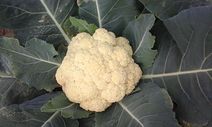Brassica oleracea 'botrytis'
| Brassica oleracea 'botrytis' | |
 | |
| Light: | |
| Moisture: | |
| Soil pH: | 5.6-8.4 |
| Self Pollinated | |
| Life Cycle: | Biennial |
| Height: | 2' |
| Blooms: | Late Spring-Late Summer |
| Edible Rating: | |
| Tea: | Yes |
Brassica oleracea 'botrytis' (common name: cauliflower) is a cultivated plant widely grown for its edible immature flower head that is eaten as a vegetable.[1]
Propagation: Seed - sow in a seedbed outdoors in April to June depending on the cultivar. Plant out into their permanent position when the plants are 5 - 10cm tall. Seed of some cultivars can be sown in late winter in a greenhouse in order to obtain a harvest in early summer. Do not let the seedlings get overcrowded or they will soon become leggy and will not make such good plants. If your seedlings do get leggy, it is possible to plant them rather deeper into the soil - the buried stems will soon form roots and the plant will be better supported.
Cultivation: Succeeds in full sun in a well-drained moisture-retentive fertile soil with plenty of lime[2][1][3]. Cauliflowers, especially the winter and spring maturing types, should not be given a soil that is too rich in nitrogen since this can encourage soft, sappy growth that is more susceptible to winter cold damage[3]. Prefers a heavy soil[4]. Requires a warm sunny position[4]. Prefers a pH in the range 6 to 7[1], though it tolerates a pH in the range 4.3 to 8.3. Succeeds in maritime gardens[1]. Lack of moisture in the growing season can cause the plant to produce small or deformed curds[3].
Summer varieties are not very cold hardy and will be damaged by light frosts, winter cauliflower plants are more hardy and will tolerate temperatures down to about -6°c, though the curds are more sensitive and can suffer damage at about -2°c[1]. This damage can often be prevented by bending over the leaves so that they cover the curd.
Cauliflowers are widely grown for their edible immature flower heads (or curd). There are many named varieties and, by careful selection, it is possible to provide a year round supply. The summer and autumn maturing cultivars are annuals, they need to produce a certain number of leaves before curd development will be initiated. The optimum temperature for this is around 17°c, but at temperatures above 20°c the curds will either be of poor quality or not be produced at all[1]. Winter and spring maturing forms are biennial and need exposure to temperatures below 10°c before they will produce curds and once again, this will not happen unless the plant has reached a certain size[1].
Grows well with celery and other aromatic plants since these seem to deter insect predations[5][6][7]. Grows badly with beet, tomatoes, onions and strawberries[6][7].
Range: A cultivated form of B. oleracea.
Habitat: Not known in the wild.
Edibility: Immature flowering head - raw or cooked[8][4][2][9]. A mild cabbage-like flavour, they make an excellent cooked vegetable and are also very acceptable in salads[K]. By careful selection of cultivars, it is possible to produce flowering heads all year round[K].
Leaves - cooked[2]. A mild cabbage flavour, they make a good cooked vegetable[K]. Do not over-harvest them, however, since this would adversely affect the production of the flowering head[K].
Usage: An extract of the seeds inactivates the bacteria that causes black rot[6][7].
Pollinators: Bees
Habit: Biennial
Soil: Can grow in light, medium, and heavy soils.
Drainage: Prefers well drained soil.
Wind: Tolerates maritime wind exposure
Seed Ripens: Mid Summer-Early Fall
Flower Type: Hermaphrodite
Heavy Clay: Grows in heavy-clay soils.
Links
References
- ↑ 1.0 1.1 1.2 1.3 1.4 1.5 1.6 Huxley, Anthony. The New Royal Horticultural Society Dictionary of Gardening. MacMillan Press, 1992.
- ↑ 2.0 2.1 2.2 Thompson, Robert. The Gardener's Assistant. Blackie and Son, 1878.
- ↑ 3.0 3.1 3.2 Phillips, Roger and Martyn Rix. Vegetables. Macmillan Reference Books, 1995.
- ↑ 4.0 4.1 4.2 Simons, Arthur. New Vegetable Growers Handbook. Penguin, 1977.
- ↑ Philbrick, Helen and Richard Gregg. Companion Plants. Watkins, 1979.
- ↑ 6.0 6.1 6.2 Riotte, Louise. Carrots Love Tomatoes. Garden Way, 1978.
- ↑ 7.0 7.1 7.2 Allardice, Pamela. A-Z of Companion Planting. Cassell Publishers, 1993.
- ↑ Chittendon, Fred. RHS Dictionary of Plants. Oxford University Press, 1951.
- ↑ Uphof, Johannes. Dictionary of Economic Plants. Weinheim, 1959.